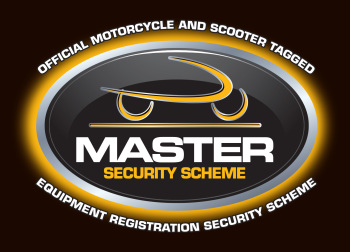New figures show that MASTER protected motorcycles are 6 times less likely to be stolen
Posted on
Recent analysis of theft data for new motorcycles sold in 2017, shows there is a huge difference between machines which are marked with the MASTER Security Scheme, compared to those which are not. New MASTER protected bikes are six time less likely to be stolen.
MASTER, which stands for Motorcycle and Scooter Tagged Equipment Registration, is the UK’s only official and national scheme and has been adopted by the majority of major motorcycle manufacturers since its launch in 2013. It both deters theft and makes it easier to secure a conviction.
What do new statistics show?
Information from the MASTER Scheme database and new registration data shows 66,423 new motorcycles and scooters were registered in the UK from the beginning of this year to the end of July 2017. 42,254 were marked with the MASTER system, of which only 78 have been reported stolen. Of the 24,169 motorcycles and scooters which were not protected by MASTER, 285 have been stolen.
Rates of theft
There is a clear and significant difference in rates of theft. MASTER tagged machines registered in the first seven months of the year have a theft rate of just 0.18%, while non-MASTER tagged new bikes have a theft rate of 1.17%, showing MASTER tagged bikes are more than six times less likely to be stolen than bikes which are not protected by the MASTER Scheme.
Steve Kenward, CEO of the Motorcycle Industry Association, which first introduced the MASTER Scheme in 2013 says:
“The MASTER Security Scheme represents a significant investment by major brands and these figures confirm that the decision to invest in the official MASTER scheme was the right thing to do. This data is very encouraging and hopefully will persuade those manufacturers not yet marking bikes to reconsider the MASTER Scheme as significant benefit to their customers.”
How does the MASTER Security Scheme work?
The MASTER Security Scheme uses a sophisticated array of technology to mark the motorcycle or scooter’s major component parts providing a unique 'fingerprint'. This layered approach involves a combination of visible and concealed elements including tamper evident warning labels, hidden microscopic Datadots, stealth UV etching and a number of unique radio frequency identification transponders which are embedded into parts. This is similar to the technology that allows the chipping of cats and dogs, but cannot be altered or erased.
The combination of hidden elements (detailed above), along with the high visibility and the unique number on each tag, offer both peace of mind to consumers and help the police secure prosecution when recovering stolen motorcycles. Police have access to the MASTER Security Scheme secure database 24 hours a day.
The MASTER Scheme system includes a highly visible ultra-destruct identification/warning label that is fixed in a prominent place on the bike (generally on the frame near the headstock), alerting potential thieves to the fact that it is marked and registered. The label disintegrates if it is tampered with and alarm bells will ring for police and subsequent owners if the label is missing on models from participating manufacturers.
All motorcycles and scooters from participating manufacturers are registered on the MASTER Security Scheme’s national secure database. This is updated continuously, which means the reporting of stolen vehicles is immediate.
It would be virtually impossible for a thief to remove all traces of the MASTER Scheme technologies from all parts, which is why this makes protected bikes far less attractive to them.
There are now over 250,000 MASTER protected machines and this number increases each year.
Facts about motorcycle theft
43% of all insurance pay outs are due to theft (according to MCIA research).
Many motorcycles are ‘cloned’, which involves being broken up into parts within hours of being stolen and reassembled onto legally acquired frames, which have log books. This can net thieves thousands of pounds a day.*
80% of these ‘cloned’ motorcycles find their way into the legitimate dealer network. Before the MASTER Scheme it was virtually impossible for dealers or the police to identify stolen parts.*
**(Facts and figures supplied by the Motorcycle Crime Reduction Group).





Add a comment: